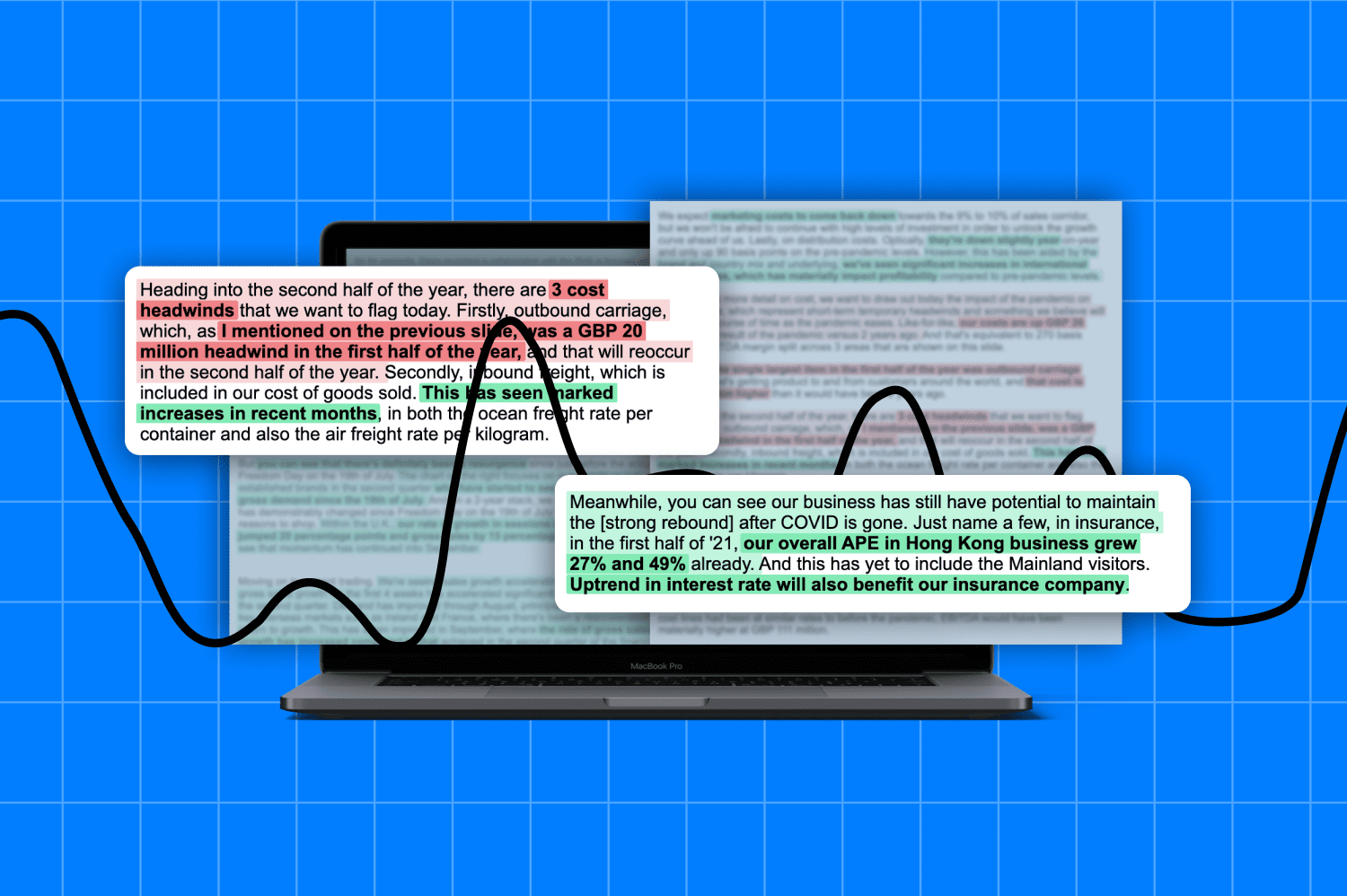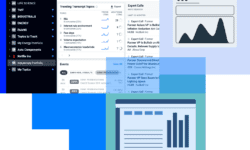With the onslaught of macroeconomic events over the last few years—the COVID-19 pandemic, global supply chain disruptions, and hyper-inflation, to name a few—it’s no shock we’ve reached the point of information overload.
Volatile markets are creating newer, greater demands for effective market intelligence research. While the constant stream of news, research, transcripts, and more contains valuable information on macroeconomic trends and market-moving events, manually gleaning insights from thousands of pages of text is an impossible task for any human. Inevitably, it requires sacrificing either breadth or depth of research, leading to blindspots or worse, missed opportunities.
However, there is another way: artificial intelligence (AI), and more specifically, Natural Language Processing (NLP).
AI and NLP allow you to swiftly sift through vast amounts of quantitative and qualitative data, surfacing the specific information you’re looking for. While the FinTech sector was an early adopter of AI technology, other financial institutions have started incorporating AI into their workflows to beat FOMO, generate alpha, and win bigger. We see this in how commonplace terms like big data, robotic process automation, and blockchain have become in the financial services industry.
With AI and NLP, financial analysts and investment managers can avoid missing out on key insights, underperforming on their benchmark, and lagging behind the competition.
What is NLP?
NLP is a subset of computer science, linguistics, and AI, which uses machine learning algorithms to help computers understand and interpret human speech. Recent advancements like deep learning, neural networks, and cloud computing are paving the way for NLP solutions to thrive in business environments.
Financial services organizations are increasingly seeing NLP as the solution to data overload and lack of bandwidth. These tools are driving competitive differentiation, mitigating risk, and generating new revenue potential.
Some of the current functionalities include speech recognition, synonym recognition, sentiment analysis, and mention tracking, all of which are featured on our award-winning market intelligence platform.
Discover the best platform for financial research and analysis. Start your free trial today.
Use Cases for NLP in the Finance Sector
Leveraging natural language processing in financial research is transformational. It saves a tremendous amount of time and ensures more accurate and comprehensive research and analysis. NLP can be used to review unstructured data, as well as spot volatility or market-moving trends that may impact financial markets.
Here are a few specific scenarios where NLP uplevels financial research:
Earnings Call Analysis
While early applications of NLP in earnings call analysis were intended mainly to save human labor by automatically skimming transcripts, new applications have emerged that focus on augmenting analyst reading capacities.
NLP computationally analyzes language patterns in an earnings call and combines it with the field of psycholinguistics to establish inferences about executives’ character and state of mind. By applying these insights to earnings calls, analysts can cross-reference the content of specific statements, understand the underlying meaning behind some of the language and phrasing, and even construct psychological profiles of the company’s senior executives.
Thus, natural language processing can be used to quantify the qualitative value signals in an earnings call. If you can quantify aspects of a company’s strategic vision, you can then model the dynamics of strategic innovation in an industry, as well as its relation to financial results.
Read more about this use case in our whitepaper, The Future of NLP Innovation.
Validate C-suite Interest in Trends
When SAP wanted to test their theory that digitally mature companies perform better than their peers, they used AlphaSense datasets paired with our NLP technology to see how C-suite executives were thinking about digital maturity and business performance topics, including cash conversion cycle and digital technology.
By utilizing NLP techniques like mention counts and filtering by industry and company, SAP was able to identify a trend line over time. When they discovered that the mention count increased over time for three of the four KPIs they measured, they were able to validate that C-suite interest was, indeed, growing.
Leveraging mention count can help you build a more effective strategy, validate a thesis, and even combat tailwinds or better yet, ride the tailwinds of a trend.
SAP: Companies Going Digital Are Running Their Best
Theme Extraction
Understanding the context around a topic or theme can be particularly useful when assessing the strengths and weaknesses of a competitor or M&A target.
M&A bankers use the AlphaSense NLP feature theme extraction to find financial metrics that are not found within standard 10-Ks and 10-Qs, as well as parse through alternative information sources for companies not covered or part of an emerging industry. They also use watchlists to stay informed on companies of interest, ensuring their due diligence is complete by never missing a critical update.
Analysts also use theme extraction to quickly identify the most relevant information at scale across every competitor’s transcript, based on metrics such as QoQ changes in mentions and positive/negative sentiment.
3 Additional NLP Applications in Financial Research
1. Understand how different industries, geographies, or companies are thinking about a topic with Search Summary
In addition to time-based insights that help uncover how trends evolve over time, teams use the AlphaSense platform to understand how different industries or geographical regions are thinking about a specific topic. For example, Reuters recently leveraged AlphaSense to understand how European companies are approaching buybacks.
Their analysis applied a simple filter in AlphaSense that limited the results to European-headquartered companies. In doing so,, they uncovered 800+ mentions of buybacks on earnings calls from European companies in Q2 2021, a significant increase over the prior quarter.
Taking this analysis a step further, the Search Summary shows the mention count per country, including the top industries and companies within the search results. All of these details provide an even wider view of the landscape.
AlphaSense Search Link: European Buybacks Mentions on Earnings Calls
Search Summary works as a powerful tool to help you gain an understanding of the market landscape. Insights into major players, key industries, and geographies can all help you generate new ideas and build powerful strategies.
2. Forecast stock behavior and fluctuations with deep learning and NLP
Predicting time series for financial analysis has historically been a challenging process. Deep learning, integrated with natural language processing, far outperforms earlier methods for working with financial time series.
By recognizing complex nonlinear relationships in financial time series data and accurately simulating nonlinear functions, NLP provides a leg up over traditional stock index prediction methodologies. Not only are these approaches helpful for predicting stock prices and stock market volatility, they can also be critical for any stock trading or investment decision.
3. Identify the tone surrounding your topic of interest with sentiment analysis
Oftentimes, by simply relying on mention counts and search summary, you run the risk of missing the underlying meaning in the document or transcript you are analyzing. Sentiment analysis is an NLP-based feature that can extract the subjective meaning of text, helping financial professionals easily spot anomalies or inconsistencies in company documents. This, in turn, leads to better-informed investment decisions and improved risk management.
Conducting sentiment analysis is simple within AlphaSense—all you need to do is add the word “positive” or “negative” to your search parameters. This type of search will return the documents containing positive or negative mentions about your topic of interest. In the example below, we see that the context in which companies are speaking about inflation is mainly negative, buybacks are primarily positive, and the economy is mixed.
Read more about this in our AlphaSense Visionaries report, where researcher Peli Greitzer (Harvard PhD, Einstein Institute of Mathematics) shares his theory on how NLP and sentiment analysis could be used for tracking company ideas and innovation before it happens.
Percentage of Topic Mentions by Sentiment on Q2 2021 Earnings Calls
Why You Need AlphaSense for Financial Research
With the myriad of unstructured data you need to analyze, from research reports to company filings and earnings calls, you need a financial research platform that understands precisely what you are searching for and that surfaces the precise insights you need to take analysis to the next level.
From millions of pages of unstructured text documents to clear and concise insights presented in bar graphs, pie charts, and heat maps, AlphaSense empowers business professionals to uncover hidden insights within the human language and ultimately make better business decisions.
Ready to discover how NLP can enhance your risk management strategy and decision-making process? Sign up for a free trial today or check out a list of curated, pre-built searches in our Search Library.







